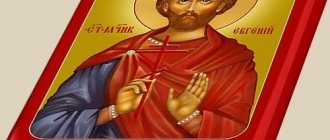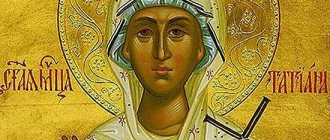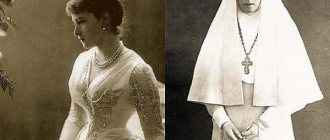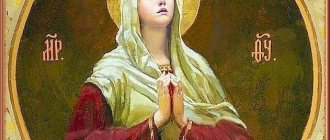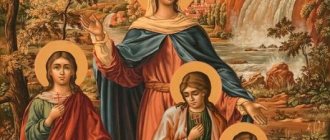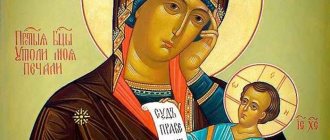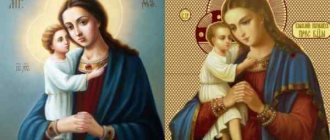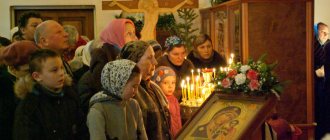Life of the Holy Martyr
Not much is known about the life of Saint Alla. Historical information about the great martyr varies. What is known is that the years of her life and martyrdom fell in the 4th century.
Alla lived on the territory of Gotfia, located on the site of present-day Crimea. According to legend, she was the wife of one of the Gothic rulers.
In 341, in Gothia, thanks to the friendship of King Valens with the Roman state, Christianity began to spread en masse. The Christian clergyman Wulfil arrived from Rome to the Goths. This period was marked by the construction of churches and monasteries, as well as the conversion of people to the Christian faith. The future martyr Alla also converted to Christianity.
But later the power was seized by the inveterate pagan Atanaric (according to other sources - Ungerik), who hated Christians. He went to war against the Roman Empire.
The war lasted about 2 years. After the conclusion of peace, Athanaric persecuted Christians, considering them spies of the Romans. His goal was the complete destruction of Christians, at the sight of whom the pagan was seized by bestial rage.
Legal proceedings were ignored, Christians were tortured and executed without any trial. To identify true believers, the king came up with a sophisticated method. A chariot with a statue of the pagan god Wotan drove along the city streets. Each resident was ordered to go to the idol with worship and sacrifice. Those who refused were seized by the ruler's henchmen and executed.
According to legend, on one day in 375, more than 300 believers gathered in one of the Christian churches to participate in worship. People asked the Lord to send peace to all Christian believers.
At this time, a chariot with an idol, accompanied by a detachment of pagan soldiers, drove up to the church. The leader of the pagans ordered everyone to leave the church and give honor to the god Wotan. But the believers, after a moment of silence, continued the service.
Then the soldiers locked the doors and, having nailed them shut, set the church on fire. All 308 believers present at the service were burned alive in the fiery flame. According to one version, Alla Gotfskaya was among the burned Christians. According to other sources, the righteous woman was not in the temple. She learned about the tragic event while she was in her palace.
Athanaric's ban on burying the dead deeply outraged the queen. She decided to act independently, since she could not rely on servants who were pagans. Her daughter Duclida helped the saint.
Two brave women came to the fire to collect the relics of burned Christians and transport them to Syria. The daughter, along with the remains of the saints, remained there, and Alla decided to return to her homeland.
The sufferer was met by her son Agathon. But as soon as the mother and son arrived at the city gates, the pagans attacked them. They threw stones at Alla and Agathon, beating them to death.
Later, the daughter of the martyr Duklida brought the sacred remains of the burned Christians to the territory of Crimea. A new temple was founded at the site of their burial, and the particles of the relics became famous for many miracles.
April 8. Holy Martyr Anna of Goth
The memory of the holy martyr Anna is celebrated on the day of remembrance of the Gotf martyrs on April 8 (March 26, Old Style).
The Goths are a people of the Germanic tribe who initially lived along the Vistula River, and then settled along the Danube River. Historical documents provide scattered and not entirely clear information about the German tribe of Goths, which appeared in the Black Sea region in the 2nd century, part of which settled in the Crimea, surrounded by Scythian, Sarmatian, and Alan tribes. Under pressure from the Huns in the 70s of the 4th century, the bulk of the Goths left for the Danube Valley. Gothia, Crimean Gothia, Gotthia is the name given to the area between the Belbek River and Cape Ai-Todor after three thousand Goths settled there, who did not leave Crimea in 448.
At the beginning of the 4th century, Christianity began to spread among the Goths. His first preacher here was Vulfila or Ulfila, the bishop of the Goths. All Gothic tribes were united under the leadership of King Athanaric. In the year 348, King Athanaric, driven by political motives, launched a persecution against Christians, and the bishop, together with his converts, was forced to retire beyond the Danube, to the borders of the empire, where in the city of Nicopolis, near the Balkans, he completed his famous translation of the Bible into Gothic and died in the year 381.
In 370, Athanaric raised a new persecution. On his orders, many of the Christians were tortured and executed, often without trial. Athanaric installed a statue in a chariot and carried Christians in front of the tents, which were used for church services. Those who agreed to worship idols and make sacrifices were spared. Death awaited the rest. During this second persecution, the Orthodox martyrs suffered, whom our church recognizes: Nikita, - 15 Sep., Savva, - 15 Apr., Vafusy and Verk with their squad, twenty-four others, - 26 March (under Tsar Ungerich, from whom the latter suffered, must mean one of Athanaric's assistants).
Saint Anna did not abandon Christian teaching. The martyrs were burned alive in the church during worship. About 300 people died in the flames, the names of some martyrs have been preserved: presbyters Vafusy and Verk; monk Arpila; laymen: Aviv, Agn, Reas, Igafrax, Iskoi, Sila, Sigitz, Soniril, Siumval, Fermus, Phyll, Constance. Martyrs: Anna, Alla, Larisa, Moiko, Mamika, Uirko, Animaisa and Gaafa. The remains of the martyrs were not allowed to be buried according to Christian rites.
During the reign of the emperors Valentinian (383-392) and Theodosius (378-395), Gaata (according to some sources - Alla), the widow of the Gothic king, who was an Orthodox Christian, and her daughter Duclida collected the relics of the holy martyrs and transferred them to Syria. Gaata later returned to her homeland, where she was stoned and martyred along with her son Agathon.
During the reign of Emperors Valentine II and Theodosius the Great, Princess Duclida transferred the relics of the holy martyrs to Cyzicus in Asia Minor and gave part of the incorruptible relics for the consecration of the temple. (Cyzicus is a region in Crimea. Founds a new city (new royal court) and there is a new temple, where he places the remains of the Gothic martyrs.)
For her commitment to Christianity and her martyrdom, which occurred around 375, Saint Anna was canonized by the Orthodox Church and is revered as a martyr.
Meaning and veneration in Orthodoxy
On March 26 according to the old style (April 8 according to the new calendar), the Orthodox Church celebrates the day of the angel of the Great Martyr Alla Gotfa. Christians have no other saint with this name.
The holy martyr gives special protection to women who bear her name. It helps them in gaining confidence and solving many problems.
They ask Saint Alla:
- help in raising children in accordance with Orthodox traditions;
- strengthen faith;
- get rid of loneliness;
- provide assistance in making friends;
- protect from enemies.
The martyr patronizes people caring for seriously ill people.
Saint Anne in Orthodoxy
In the Orthodox faith there are several famous women named Anna who are saints.
- Anna the Prophetess
. During her righteous life, she was able to see the newborn Christ, so that she could then preach the Good News. Memorial Day – February 16th. - Saint Anne the mother of the Virgin Mary
. The woman made a vow that if she gave birth to a child, she would bring it to the Lord to serve. Her words were heard, and the Mother of God was born. Memorial Day of Saint Righteous Anna: August 7, September 22 and December 22. - Anna of Adrianople
. The girl believed in Jesus after attending the execution of Bishop Alexander, who, thanks to prayer, was able to endure the torment. She stood up for him and was killed. They remember her on November 4th. - Saint Anna of Bithynia
. A believing woman accepted monasticism, and in order to save herself from persecution she disguised herself as a man. In this image she became a preacher and miracle worker. Memorial Days: June 26 and November 11. - Anna Gotfskaya
. For her faith in the Lord, she was burned alive in the church. Memorial Day – April 8. - Anna Kashinskaya
. After the death of her relatives, the woman became a nun. After her death, the relics began to heal people. Memorial Days: June 25 and October 15. - Saint Anna of Novgorod
. The woman lived a pious life and in old age became a nun. She is venerated on February 23. - Anna Rimskaya
. The girl gave dinner to celibacy and remained faithful to the Lord all her life. The Orthodox Church honors her on February 3 and July 18. - Anna Selevkiyskaya
. The girl died in agony for her faith. Memorial Day – December 3.
Iconography
The icon of Alla Gotfa can be seen in many churches. On the icon the sufferer is depicted from the waist up. Like all martyrs, the saint wears red clothes, symbolizing the blood shed for the faith. With her right hand the saint holds a cross - a symbol of the suffering of Christ. The left hand is raised and faces the worshipers with an open palm. This gesture speaks of the righteous woman’s openness to people. Around the sufferer’s head is a round halo, reflecting the Divine light.
The icon of the holy martyr demonstrates a person’s readiness to serve God. Regardless of whether a person believed from childhood or came to the Lord in adulthood, he will no longer be able to give up.
Anna Gotfskaya. Saint Anna of Goth
Business ideas
In the mid-1930s, priests arrested in the late 1920s began to return from exile and imprisonment. The Renovationists, who during this time, with the support of the authorities, seized many Orthodox churches, although they had difficulty holding them, having no flock, they did not want and could not give in - the OGPU incited them to fight Orthodoxy. Among the victims of this struggle was Anna Shashkina, a simple peasant woman who had wanted to become a nun since childhood.
*** Martyr Anna was born on February 13, 1888 in the village of Pigaskino, Poshekhonsky district, Yaroslavl province, into the family of peasant Vasily Shashkin. After graduating from a rural school, Anna lived with her parents and eventually intended to enter a monastery. She often went to the Pavlo-Obnorsky Monastery, located in the Vologda province, to its abbot and her spiritual father, Archimandrite Nikon (Chulkov), to whom many then turned for advice and prayerful help. Among them there were many women and girls, and Father Nikon subsequently founded a monastic community in the village of Zakharyevo, Yaroslavl province, for those wishing to pursue asceticism. It was the last monastery formed in 1918 in Soviet Russia, which existed under various forms almost until the end of Soviet power. Here people strived for the salvation of their souls and for perfection. Here one could clearly feel the presence of God among the people gathered here, who, even in conditions of severe persecution, kept the commandments and remained faithful to Christ. The monastery-community existed first under the guise of an agricultural artel, and then a commune. As before the Pavlo-Obnorsky Monastery, so after its closure, the monastic community in Zakharyevo was actively visited by believers who came for advice and instructions to Archimandrite Nikon, who settled here.
In 1936, renovationists in the city of Poshekhonye-Volodarsk wrote a complaint to the authorities, asking to transfer the Assumption Church to them: “Due to extremely complicated circumstances on the part of the Tikhonov community at the Assumption Church in the city of Poshekhonye-Volodarsk, which are expressed in an open struggle against the renovationist orientation. They openly denounce the temple as heretical
Tikhonites very often have illegal meetings. On January 7, 1936, Aleksey Evgrafovich Smirnov, as the main leader of the Tikhonov community, in the evening gathered guests, about twenty-five people, including priest Peter Bogorodsky, Abbess Leonida, many former nuns and other persons, and this feast ended well after midnight . Why can't this be an illegal meeting? After all, we don’t know what they were talking about.
In addition, taking advantage of the influx of Christmas festivities, slander and slander went to all the villages of the area with a call for a boycott with all their might of all renovationist clergy, seducing the dark forces with faith in the holiness of God only Tikhonshchina. Seeing all this closely as a nest of hostility and illegality, we ask you to hand over the temple to us, in order to avoid consequences, as well as the reluctance to have such neighbors, where, in addition to religious purposes, the remnants of the former royal habits are pursued
Therefore, we once again earnestly ask you, in order to avoid all consequences not only for our temple, but also for the region, to stop at the root the development of this nest of illegality and hand the temple over to us, the renovationists.”
At the end of 1936, officers of the Yaroslavl NKVD began arresting the clergy and believers in the region. On January 10, 1937, Anna Vasilyevna Shashkina was summoned for questioning, and the investigator asked her if it was true that she had collected signatures from residents who wanted to belong to the Tikhonov community. Anna Vasilievna explained that in 1935, her brother’s son died, and their parish priest Peter Bogorodsky refused to participate in his burial, pointing out that the residents of this village do not belong to the Orthodox community, and let them first decide whether they will go to an Orthodox church or to the renovationists; then she undertook to collect signatures of residents - those who consider themselves Orthodox.
What orientation do you belong to? - the investigator asked her. “I personally belong to the Tikhonov orientation,” answered Anna Vasilyevna. - Why then did Bogorodsky demand signatures for the Tikhonov community from your entire village? - I can’t explain this. — In connection with the USSR census, counter-revolutionary provocative rumors were spread among the population of the city, emanating from the contents of the book “The Protocols of the Elders of Zion” and your reasoning about the coming of the Antichrist, about the press, and so on. You spread these rumors with the aim of disrupting the census activities of the Soviet government. Do you confirm this?
No, I deny this, I did not spread any counter-revolutionary provocative rumors and I did not hear anything about these rumors.
Summoning Anna Vasilievna for questioning the next time, the investigator began to press her to tell her how long ago she had heard about Archimandrite Nikon and from whom, but she refused to answer this question. On March 4, 1937, the investigator again summoned her for questioning and again began to ask about Father Nikon: how long and how closely she had known him, but this time she did not answer anything; and on the same day the investigator announced to her that she had been arrested as a suspect.
On March 18, the investigator, calling Anna Vasilyevna for questioning, asked: “How long did you live in the Nikon “commune”? — I was not a member of the Nikon “commune,” but I was in the “commune” several times. — Why did you visit the “commune”? Anna Vasilievna refused to answer this question. — Did you know that Nikon’s “commune” was essentially an illegal monastery organized to fight Soviet power? Anna Vasilievna refused to answer this question either. — Which members of the “commune” did you visit? — In the “commune” I stayed with the head, Anna Aleksandrovna Solovyova. — How do you know Solovyova? “I knew Solovyova through her aunt, nun Taisiya. In addition, when Solovyova was in the city, she stayed with me. - Having a connection with the leader of the “commune”, you could not help but know the goals and objectives of this “commune”. The investigation requires frank testimony from you.
Anna Vasilievna refused to answer this question. On April 3, the last interrogation took place, during which the investigator again tried to find out from Anna Vasilyevna what she knew about the whereabouts of Archimandrite Nikon.
“I have no connection with Archimandrite Nikon, and I don’t know where he is currently,” answered Anna Vasilievna. — Why and to whom did you go in the fall of 1936 to the Tutaevsky district? — In the fall of 1936, I actually went to visit a friend of mine named Evdokia... I don’t know her last name. She was there for three days. — How do you know Evdokia? — I’ve known Evdokia for a long time. When I used to go to Tutaev, I would stay overnight with her, and when she was in the city, she would also spend the night with me. - How come you don’t know her last name? “I really don’t know her last name, and I don’t know what she does.” - You are clearly lying. You traveled to the Tutaevsky district to visit Archimandrite Nikon, who is hiding from punishment and carrying out active counter-revolutionary work. I demand frank testimony from you. - No, I haven’t been to Archimandrite Nikon, and I don’t know where he’s hiding. — Why was your uncle, Alexander Fedorovich Shashkin, shot, and why was his son, Vasily Alexandrovich Shashkin, imprisoned?
My uncle was indeed shot in 1918, but for what, I don’t know. I also don’t know why his son was imprisoned. On August 15, 1937, a Special Meeting of the NKVD sentenced Anna Vasilievna to five years in a forced labor camp, and she was sent to the North-Eastern camps. Anna Vasilievna Shashkina died on May 11, 1940 in a separate Mylga camp in the North-Eastern NKVD camps and was buried in an unknown grave.
Translated from Hebrew, the name Anna
means: graceful, comely, merciful, grace. According to the metaphysical comparison of names, Anna is the female counterpart of the male name Alexey.
This is a beautiful and simple name with a pronounced semantic load - as if the embodiment of something big, smooth, loud and brave, and at the same time courageous and slow. It radiates a soft light and calm humility. For more than two thousand years it has carried its beauty, reliability and majesty, while enjoying great popularity in many countries of the world.
One of the patron saints of this beautiful name is the mother of the Blessed Virgin Mary - Anna the Righteous
. According to ancient Christian legends, Saint Anna and her husband, the righteous Joachim, prayed to the Lord for many years to conceive a child, since in those days childlessness was considered a punishment from God and a grave misfortune. And only in their seventh decade did an angel of God tell the couple that they would soon have a child who would bless all the tribes of the world.
The Orthodox Church calls Anna and Joachim Godfathers, since they were the ancestors of Jesus Christ.
Another patron of the name Anna is the Novgorod princess Anna the Blessed, the wife of the great Old Russian prince Yaroslav the Wise. She provided all her children with a true Christian upbringing, which is why they were distinguished by their unshakable faith in God, hard work, truthfulness and learning.
Anna's only son, Mstislav, later became the great and glorious prince of Kyiv, while her daughters became queens of the states of Western Europe.
In her declining years, the blessed princess decided to go to a monastery, where she died in 1056 in strict obedience and prayer.
Like all patron saints, modern Annas are distinguished by their extraordinary meekness of character
. They have very developed intuition, sometimes it even seems that they are able to read people's souls. However, they will never use their “clairvoyance” for selfish purposes. And even vice versa - having guessed a person’s “sore spot”, they will try to become a “balm for the wound”.
Sometimes it may seem that Anna herself is looking for suffering. She may throw in her lot with a sick or heavy drinking person, or even just a loser. Moreover, she is humbly ready to bear this cross all her life! He will never complain about anything. She is a faithful wife, a good friend, and the most caring mother...
At the same time, she never forgets about her appearance. Thanks to her delicate taste, she always dresses in an original and unpretentious way. She organically cannot tolerate sloppiness - even after many years of marriage she will not risk appearing in front of her husband in a dirty robe, torn slippers and with an unkempt hairstyle. In marriage, she is able to forgive a lot, except for betrayal.
Name day days
Anna:
February 3, July 18
– Martyr Virgin Anna of Rome.
February 16, September 10
– Anna the Prophetess, daughter of Phanuel.
February 23
– Reverend Princess Anna of Novgorod.
April 8
– Martyr Anna Gotfskaya.
June 25, October 15
– schema-nun Princess Anna Kashinskaya, Tverskaya.
June 26, November 11
– Venerable Anna of Bithynia.
August 7, September 22, December 22
– Mother of the Most Holy Theotokos, Anna the Righteous.
November 4
– Martyr Anna of Adrianople.
December 3
– Martyr Anna of Seleucia.
December 22
– mother of the prophet Samuel, Anna the Prophetess.
In our section “Holy New Martyrs of the Solbinsk Iconostasis” we continue the conversation about the saints of the Yaroslavl diocese. Previously, we wrote about a secret women’s monastery that existed under the guise of an agricultural artel and about its nuns. But there were also those who were not members of the secret sisterhood and did not accept the rank of angels, but whose faith in Christ remained firm and unshakable in the most severe years of persecution. Today we will talk about the New Martyr Anna Shashkina, a simple peasant woman from a village near Poshekhonye, whose entire short and difficult life shows us the true feat of courage and genuine faith in Christ.
Anna Vasilyevna Shashkina was born in February 1888, into a simple peasant family in the village of Pegaskino, and was named in holy baptism in honor of the prophetess Anna. Living in the countryside from birth and running a household with her parents, she graduated from a village school, receiving a primary education, and eventually planned to enter a monastery, devoting herself to the service of the Lord.
But a different, terrible time came, all Russian monasteries were closed, destroyed, transformed into agricultural cooperatives and communes. Anna Vasilyevna, like Maria of the Annunciation, later a secret nun and martyr, was the spiritual daughter of Archimandrite Nikon (Chulkov), abbot of the Pavlo-Obnorsky Monastery. While the monastery was still operating, Anna Vasilyevna came there, near the Vologda town of Gryazovets, for spiritual nourishment. When the monastery was closed and a secret women's monastery appeared, Anna Vasilievna began to visit it, without leaving spiritual guidance from Father Nikon and at times working in the secret monastery. This subsequently cost her her freedom, and then her life.
The 30s came. The terror against believers did not weaken, but then, in the early 30s, many priests briefly returned to their native places, to their churches and flocks, only to find themselves in prison again after a short time and, for the most part, won the crown of martyrdom. But many churches at the turn of the 20s and 30s find themselves captured by renovationists. The question of their return arises. Anna Vasilyevna takes on the difficult and unsafe task of collecting signatures from the surrounding villages for the return of churches to supporters of Patriarch Tikhon. From the renovationists, denunciation after denunciation comes to the local organs of the OGPU. At this time, the secret convent under the leadership of Archimandrite Nikon was already being destroyed (but not destroyed), and he himself went underground, hiding in remote villages and maintaining secret communication only with the most faithful spiritual children. One of them is Anna Vasilievna Shashkina. She works on the state farm, never ceasing to live a rich spiritual life in these terrible conditions, openly defending local churches from renovationists and secretly supporting her persecuted confessor.
The 37th year is coming. The number of “enemies of the people” is increasing even more. They begin to summon Anna Vasilyevna for interrogation, inquiring about the whereabouts of Father Nikon (Chulkov), his secret abode, and issues of protecting Orthodox churches. One of the interrogations in the early spring of 1937 ends with the arrest of Anna Vasilievna. The interrogations now continue at a new, terrible stage. Anna Shashkina is in chains. And here one is struck by the endless fortitude and courage of this simple Russian peasant woman, who was not at all afraid of her tormentors and did not succumb to them in any way. She could answer a number of questions evasively, avoid a direct answer and ward off the blow of the executioners, but the spirit of this Yaroslavl peasant woman soars too high, she does not consider it possible or necessary for herself to seek justification and earthly salvation. She is asked questions about the purpose of her visit to the secret monastery, what conversations she had with her confessor and what she knows about his whereabouts, but she declares that she refuses to answer. The terrible 37th is underway, death sentences are being passed en masse, and “special methods of inquiry” are officially allowed to be used in relation to the “enemies of the people” under investigation. And Anna Vasilyevna Shashkina tells the executioners that she will not answer them. The trial follows very soon. Already in April she was sentenced to five years in the northern camps.
Exactly three years later, in May 1940, unable to withstand the horrific conditions of Soviet penal servitude, Anna Vasilievna dies in the camp hospital. She is 52. She leaves for another world, without betraying anyone who walked with her on her difficult but straight path of deep and devoted faith in Christ. At the beginning of our century, the laywoman Anna Vasilievna Shashkina was glorified among the new martyrs and confessors of Russia for church-wide veneration.
Koblenz-Nikiforova Anna Alexandrovna
, art critic,
permanent lecturer at the Nikolo-Solbinsky convent,
Holy Martyr Anna of Gothia is an early Christian saint who lived in the 4th century in Gothia (the territory of modern Crimea) during the reign of the pagan king Athanaric, an ardent persecutor of Christians. Despite the danger, Anna professed Christianity and regularly attended secret services. For her religion, the saint was burned in 375 along with other 308 Christians during a service in the temple. History knows the names of only 26 martyrs who died along with Anna of Gotfskaya. The most famous of them is Queen Alla Gotfskaya.
Saint Anna of Goth is revered in Orthodoxy as the heavenly patroness of all women who bear her name.
Revered icons of Anna Gotfskaya, day of memory and relics of the saint
Celebrations in honor of St. Anna of Gottha take place once a year - April 8
(March 26, old style). This date coincides with the day of the death of Anna and other martyrs who died with her during the service in the temple.
Icons of the martyr Anna of Goth
Today in Russia there are no churches consecrated in honor of St. Anna of Gottha, and the temple icon of St. Anna of Gottha is a great rarity. Therefore, if you want to pray to this saint in front of her image, it would be best to make her icon to order in an icon-painting workshop.
Relics of Anna Gotfskaya
We know nothing for certain about the location of the relics of St. Anna of Goth. We only know that after the burning of the martyrs in the temple, it was forbidden to bury them according to Christian tradition. However, the widow of the Gothic king Gaata and her daughter Duclida secretly collected their relics in the burnt temple and transferred them somewhere to Syria. And a little later, Duclid brought part of the relics of the Gothic martyrs from Syria to a temple located in the now destroyed city of Cyzicus in Asia Minor (the territory of modern Crimea).
What helps and what to pray for in front of the icon of St. Anna of Goth?
They pray to the Holy Martyr Anna of Goth for help in choosing the righteous path in life, for strengthening the Christian faith, and also for the granting of spiritual strength in the face of difficulties. They also turn to her with prayers for the resolution of material difficulties, protection from ill-wishers and other adversities of life.
Prayer
A short prayer to Saint Anne for every day
Pray to God for me, holy servant of God Anna, as I diligently resort to you, an ambulance and prayer book for my soul.
Life of the Martyr Anna Gotfskaya
Very little information has reached us about the life of Anna Gotfskaya. They were mainly written in the ancient synaxarium of the Gothic Church. It is known that Saint Anna was born and lived in the 4th century in Gotthia on the territory of modern Crimea. At this time, the Roman Empire was ruled by the emperors Valens, Valentinian, and then Gratian. All of them were pagans and cruel persecutors of Christians.
Christian teaching came to the territory of Gotthia in 341, along with the first Christian priest, who brought it here and began his sermons. At that time, many people living in these parts were converted to the Christian faith, but they often preached it in secret, so as not to incur the wrath of the rulers.
Gothia, which consisted of many clans, was ruled in those years by the pagan king Athanaric. His hatred of Christians was immeasurable. On his orders, raids were constantly carried out in churches and places of possible Christian services. Saint Anna, despite her young age (she was only 17 years old at the time) and the dangers awaiting her, preached the Christian faith openly, constantly communicating with her brothers and sisters in Christ and attending Christian services. The main preacher of Christianity among them was the Arian bishop Ulfilas. Arianism was one of the earliest Christian movements, which affirmed the created nature of God the Son and his non-consubstantiality with God the Father.
One day, during one of the secret services, which was attended by more than 300 people, Athanaric’s warriors came to the temple. By order of their king, the soldiers closed the temple on all sides from the outside, so that no one could leave it, and set it on fire. As a result, almost all Christians died in the fire. We have only received information about 26 people who were present at the service on that terrible day. One of them was Saint Anna of Goth.
The other 26 holy martyrs were the presbyters Vafusius and Verk, the monk Arpila, the Gothic queen Gaafa and her daughter Princess Duclida, Prince Agathon, the parishioners of the temple Igathrax, Sila, Aviv, Constance, Ferm, Soniril, Suimvl, Agn, Reas, Iskoy, Sigits, Phyllus , as well as martyrs Anna, Uirko, Mamika, Larisa, Moiko, Animaisa and Alla.
Atanarich also, under penalty of death, forbade people to bury the remains of burnt martyrs according to Christian customs. However, Queen Alla Gotfskaya and her daughter Duklida, who miraculously survived the fire, were secretly able to collect the remains of the relics of Christians and transport them to Syria. After some time, Duklida transported part of these relics to the now destroyed city of Kizlik and gave them for the consecration of a Christian temple built in a cave.
Anna of Russia or Hanna of Kyiv? What do we know about the daughter of Yaroslav the Wise, who became the queen of France
History, unfortunately, has preserved very little news about this woman. In Russian chronicles, there is no mention of her, or her sisters, at all.
Old Russian people. Scientific myth or historical reality
©
cyrillitsa.ru
At one time it was believed that girls, including Anna, were depicted on one of the frescoes of the Kiev St. Sophia Cathedral built under Yaroslav the Wise . However, in the 80s of the last century, this opinion was challenged by Soviet historians. They argued that the location of the fresco did not correspond to the Byzantine tradition - if it depicted the grand ducal daughters, it should have been located in a different place.
The exact date and even year of birth of Anna Yaroslavna .
The French believe that she was born in 1025. There is another version - 1032. It is listed in the Tatishchev News - a kind of chronicle compiled by the pioneer of Russian historical science, an associate of Peter I, Vasily Nikitich Tatishchev . He wrote his work on the basis of chronicles, many of which were either subsequently lost (as a result of the Moscow fire of 1812) or are considered falsified - there is still no consensus.
One way or another, in the first half of the 11th century, the Grand Duke of Rus' Yaroslav the Wise gave his daughters in marriage to European monarchs, thereby building his foreign policy.
He started not even with his daughters, but with his sister Maria Dobronega , whom he married to the Polish prince Casimir I in 1038. In the same year, the middle of his daughters, Anastasia Yaroslavna , married the Hungarian Duke Andras (Andrey) . With the active assistance of his father-in-law, 8 years later he became the Hungarian King Andras I.
A day in history. July 15: the founder of the Russian state died
©
RIA Novosti, Evgeny Odinokov / Go to photobank
In 1046, the eldest daughter of Prince Yaroslav - Elizabeth (in the Scandinavian version Ellisiv) - married another European political emigrant - Harald III Sigurdarson . He, also largely thanks to his father-in-law, managed to sit on the Norwegian throne. True, although he composed enthusiastic songs dedicated to the princess before the wedding, two years after the start of his reign he married another woman.
Fate destined the youngest daughter of the Grand Duke to travel further than any of his children.
At first, her hand or Anastasia’s hand was offered to the German Emperor Henry III - Prince Yaroslav was acquiring allies on the eve of the planned war with Byzantium. At the beginning of 1043, a special Kiev embassy arrived in Goslar to conduct negotiations. However, the Germans were more concerned about the conflict with France, so the emperor refused Yaroslav's proposals and married Agnes of Aquitaine , whose father William V owned a significant part of the lands of modern France.
But the French became interested in Anna.
In 1048, a royal embassy went to Kyiv. The Reims Gloss indicates that the mission was headed by Bishop Roger . In addition to courtship with the princess, he was also tasked with finding out how far from Kyiv Chersonese was, where, as European churchmen knew, the relics of St. Clement rested. Yaroslav told Roger about his visit to this Byzantine city and that the heads of St. Clement and his disciple Thebes were transported by him to Kyiv, and even showed them.
Another source - the chronicle of the Abbey of Saint-Pierre le Vif in Sens - reports that the embassy was headed by the bishop of the city of Meaux, a certain Gautier , and one of the king’s vassals, Goslin de Chauny . Perhaps this was the second embassy that brought the princess to France three years after the visit of the first delegation.
How the Pechenegs and Polovtsians tormented Rus'
©
Public domain
On May 19, 1051, on Pentecost, the wedding took place. The division of the Christian Church into Catholic and Orthodox occurred only three years later, so there were no confessional obstacles to the marriage of the French king and the Russian princess.
The fact that “the daughter of the king of the Russians, Anna” became the French queen, is reported by a certain Hugon of Fleury . It is curious that on jointly signed documents the European monarch put a cross instead of a signature, which indicates his... illiteracy. Anna signed her name in Cyrillic: ANA RIINA.
© N. A. Genkina
It is believed that, among other jewelry in her dowry, Anna may have brought the Church Slavonic handwritten Gospel, or rather its first part, which is written in Cyrillic. The second, written in Glagolitic alphabet, dates back to a later period - the 14th century. Some scientists attribute the first part to this time. In our time, this book is kept in the Reims Cathedral, which is why it is called the Reims Gospel. Since at least the 16th century, French kings have sworn allegiance to it.
Anna began her family life and had children. In 1052, the firstborn appeared, the heir to the throne, who after 7 years was to become the next king, Philip I. Before the appearance of the Russian princess in France, this Greek name, meaning “lover of horses,” was not found among European monarchs. Three years later, their daughter Emma was born. Then there were two more sons, of whom one child, Robert, died in infancy, and Hugo later became Count of Vermandois.
Judging by the fact that while the king was alive, Anna’s name was almost never found in royal charters, his attitude towards her was cool. Her name appears in the last months of the reign of Henry I, when it became clear that she would soon become a guardian to the young king. True, it is not mentioned in the detailed account of the coronation of Philip I.
A day in history. April 18: Ukraine is mentioned for the first time in historical sources
©
runivers.ru /
A letter from Pope Nicholas, dated 1059, addressed to Anna, has been preserved: “The rumor of your virtues, delightful maiden, has reached our ears, and with great joy we hear that you are fulfilling your royal duties in this very Christian state with commendable zeal and remarkable intelligence.”
Soon, however, the papal throne changed its opinion about the daughter of Yaroslav the Wise - she remarried.
Until 1061, she shared custody of her son with Baudouin of Flanders, but in the same year her signature disappears from the royal acts. Apparently, it was then that she became the wife of Count Raoul de Crepy . As a dowry from her deceased husband, her second husband received from Anna Senlis, the region of Melun and a number of possessions between Lan and Chalons. De Crepy had previously owned a significant part of the territory of modern France, and now he became simply one of the most influential people in the kingdom.
For the sake of marriage with the dowager queen, this feudal lord accused his second wife of adultery, drove her away and, without waiting for permission from the clergy for divorce, married Anna Yaroslavna. In addition, the count was a relative of her first husband. According to the laws of that time, this was considered bigamy and adultery. “Repression” followed from the royal court and the church.
The Pope excommunicated de Crepy from the church. The king forbade the “newlyweds” to appear at court. He changed his anger to mercy only 9 years later, in 1070, and solely for mercantile reasons - the War for the Flanders Succession was expected, and he needed allies, and the lands of his stepfather lay between Paris and Flanders.
Historical myth: how the Muscovites-Moksha stole the Russian name from the Ukrainians
©
Ivan Bilibin. Illustrations for fairy tales by A.S. Pushkin
Raoul de Crepy died on September 8, 1074, and Anna Yaroslavna returned to court.
Her last autograph is on a document dating back to 1075. In it she is listed simply as “the king’s mother,” that is, by that time she had already lost her royal title.
The exact year of her death is unknown. Judging by the time her name appears in the ecclesiastical commemorations of the monastery of Saint-Vincent in Senlis, she died on the 5th of September between 1075 and 1079.
The place of her burial is unknown. Most likely, it was located in the same Saint-Vincent, because the monastery was founded by her in 1065, but during subsequent reconstructions the grave was lost. In gratitude to the Russian princess, in the 17th century in Saint-Vincent, in honor of Anna, a sculpture of her was installed with a small model of the temple she founded in her hand. Ukrainian sculptors later borrowed this idea when they created a sculpture in honor of her father, which stands in Kyiv near the Golden Gate.
Centuries have passed. In 1991, Anna Yaroslavna’s hometown became the capital of a new state - Ukraine, whose politicians eagerly set about reshaping history. They needed to put it together in such a way as to explain to the population under their control why Ukraine is not Russia and why they should control the destinies of the people inhabiting this land and its wealth, and not anyone else.
Historical myths. Where did the ancient Ukrainians come from and who descended from them?
©
RIA Novosti, V. Shiyanovsky / Go to photobank
Princess Anna also came into their sight.
To begin with, in all books and textbooks they began to call her Ganna, although she even signed herself differently. But who cared about this and when in Ukraine, how was it really, if we are talking about the historical self-determination of the country?
Secondly, they began to call her not the Russian princess, as she is mentioned in all Western sources, but the Kyiv princess.
To “stake out” this moment, Ukrainian leaders insisted that in 1996, in the Abbey of Saint-Vincent, the signature under the 17th-century sculpture be changed. If earlier it said “Anna of Russia, Queen of France”, now it says “Anna of Kiev...”. The ceremonial change of the sign was attended by the Ambassador of Ukraine to France Yuriy Kochubey , other officials and representatives of the local Ukrainian diaspora (and these people later say that their eastern neighbors took away their right to be called Russians, Rus or Ruthenians).
© necto-shuhrich.livejournal.com
Further more.
In 2005, the chief beekeeper, Tripoli expert and part-time President of Ukraine, Viktor Yushchenko, opened another monument in Senlis dedicated to Anna Yaroslavna with the same inscription: “Anna of Kiev, Queen of France.”
On November 10, 2021, a sculpture dedicated to Yaroslavna in her childhood image appeared in Kyiv. She was installed on Lviv Square with the same signature, claiming that she is Anna of Kiev. Moreover, her crown, strange for a Russian princess, is somewhat reminiscent of the headdress of the American Statue of Liberty. On November 19, 2021, a copy of the sculpture was installed in Krakow, Poland, on the territory of the Wielopolski Palace.
Was Daniil Galitsky the first Ukrainian king?
©
credo.pro / Go to photobank
A real political battle broke out around Anna Yaroslavna after Russian President Vladimir Putin said at a press conference on May 29, 2021 that Russian-French relations have a much longer history than the embassy of Peter I to France, and remembered Anna Yaroslavna.
In Ukraine, bubbling waves of “popular” anger immediately arose. Ukrainian President Petro Poroshenko was the first to react. The very next day, May 30, he said that Russia was trying to steal its Ukrainian princess from Ukraine and wanted to encroach on “Ukrainian deep historical European roots and ascribe it to itself.”
Next, the baton of the struggle for “historical justice” was picked up by numerous Ukrainian and pro-Ukrainian politicians, historians, publicists, media activists and other bloggers.
In the rising tide of verbiage that was far from historical science, a few sober statements were drowned. For example, few people have heard the honored Ukrainian historian, academician of the National Academy of Sciences of Ukraine, director of the Institute of Archeology of the National Academy of Sciences of Ukraine Petro Tolochko :
Ukrainian historical myths: Cossack Ivan Sirko – “national hero of France”
©
Public domain
“By ethnicity and state, Princess Anna Yaroslavna was Russian. Putin said everything correctly. And her place of residence was Kyiv. I see no reason for our political scientists and politicians to be outraged.”
The scientist sees no reason for indignation, because he thinks like a scientist, and not like a politician. After all, from his words it follows that the land from the Carpathians to the Seversky Donets, from Polesie to the Wild Field has been Russia since ancient times. To admit this to modern Ukrainian politics means to admit to the absence of any historical basis for its political and economic claims.
That is why Ukrainian politicians are trying at all costs not to advertise that the same Banderaites called themselves back in the 20s and 30s... Rusyns, not Ukrainians. That the territory of Galicia and Volyn in the Polish administrative division was called... Russian Voivodeship and that the princes who reigned in Kyiv and the princesses born in this city were... Russian.
